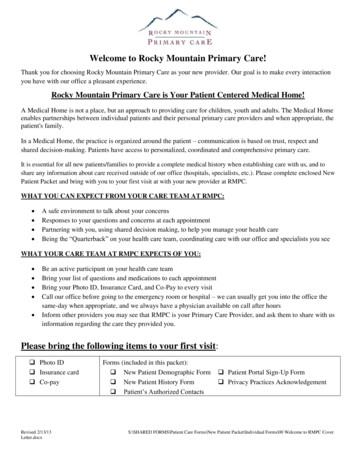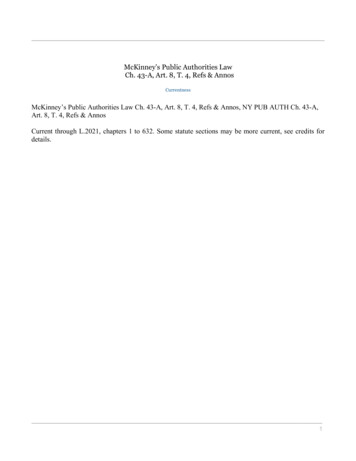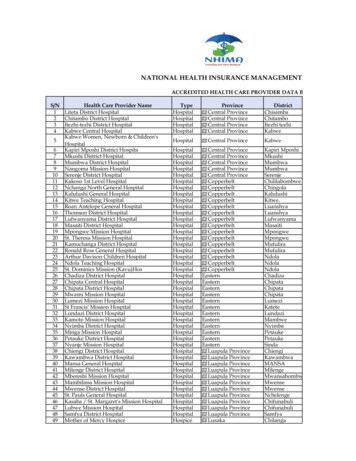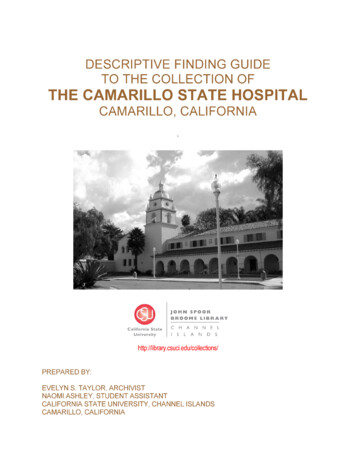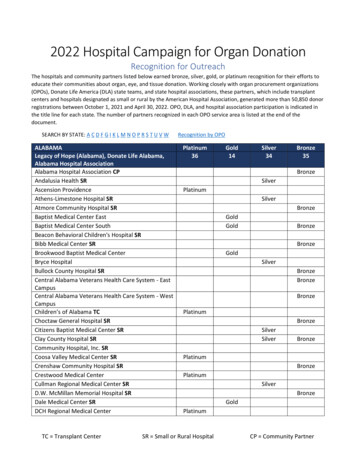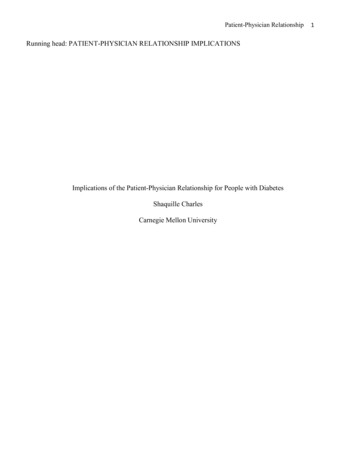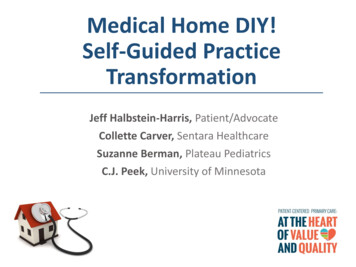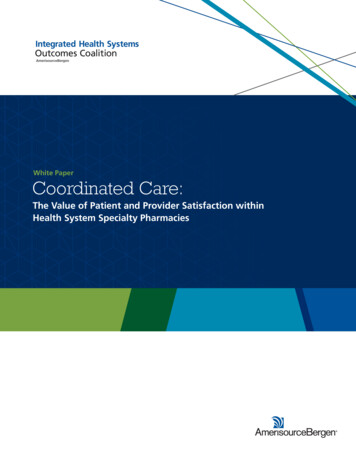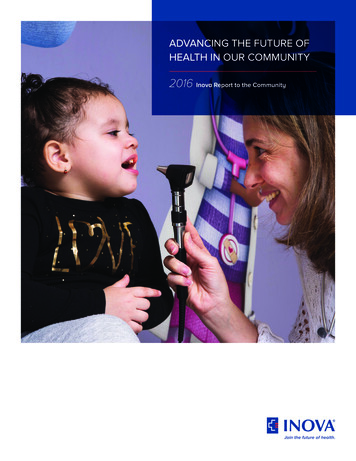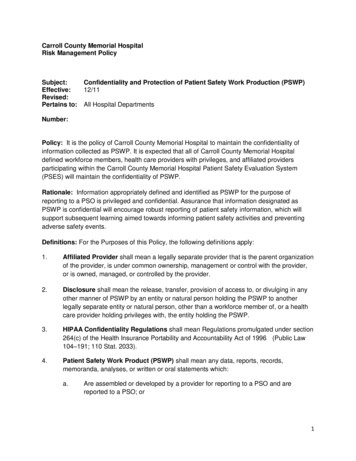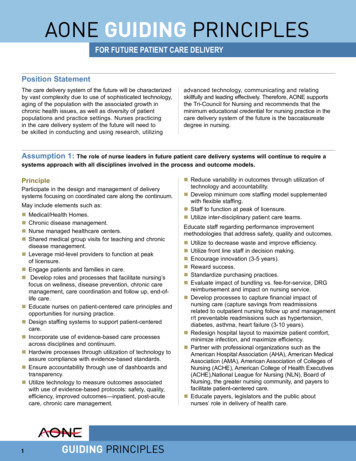
Transcription
AONE Guiding PrinciplesFor future PATIENT care deliveryPosition StatementThe care delivery system of the future will be characterizedby vast complexity due to use of sophisticated technology,aging of the population with the associated growth inchronic health issues, as well as diversity of patientpopulations and practice settings. Nurses practicingin the care delivery system of the future will need tobe skilled in conducting and using research, utilizingadvanced technology, communicating and relatingskillfully and leading effectively. Therefore, AONE supportsthe Tri-Council for Nursing and recommends that theminimum educational credential for nursing practice in thecare delivery system of the future is the baccalaureatedegree in nursing.Assumption 1: The role of nurse leaders in future patient care delivery systems will continue to require asystems approach with all disciplines involved in the process and outcome models.PrincipleParticipate in the design and management of deliverysystems focusing on coordinated care along the continuum.May include elements such as: Medical/Health Homes. Chronic disease management. Nurse managed healthcare centers. Shared medical group visits for teaching and chronicdisease management. Leverage mid-level providers to function at peakof licensure. Engage patients and families in care. Develop roles and processes that facilitate nursing’sfocus on wellness, disease prevention, chronic caremanagement, care coordination and follow up, end-oflife care. Educate nurses on patient-centered care principles andopportunities for nursing practice. Design staffing systems to support patient-centeredcare. Incorporate use of evidence-based care processesacross disciplines and continuum. Hardwire processes through utilization of technology toassure compliance with evidence-based standards. Ensure accountability through use of dashboards andtransparency. Utilize technology to measure outcomes associatedwith use of evidence-based protocols: safety, quality,efficiency, improved outcomes—inpatient, post-acutecare, chronic care management.1Guiding Principles Reduce variability in outcomes through utilization oftechnology and accountability. Develop minimum core staffing model supplementedwith flexible staffing. Staff to function at peak of licensure. Utilize inter-disciplinary patient care teams.Educate staff regarding performance improvementmethodologies that address safety, quality and outcomes. Utilize to decrease waste and improve efficiency. Utilize front line staff in decision making. Encourage innovation (3-5 years). Reward success. Standardize purchasing practices. Evaluate impact of bundling vs. fee-for-service, DRGreimbursement and impact on nursing service. Develop processes to capture financial impact ofnursing care (capture savings from readmissionsrelated to outpatient nursing follow up and managementr/t preventable readmissions such as hypertension,diabetes, asthma, heart failure (3-10 years). Redesign hospital layout to maximize patient comfort,minimize infection, and maximize efficiency. Partner with professional organizations such as theAmerican Hospital Association (AHA), American MedicalAssociation (AMA), American Association of Colleges ofNursing (ACHE), American College of Health Executives(ACHE),National League for Nursing (NLN), Board ofNursing, the greater nursing community, and payers tofacilitate patient-centered care. Educate payers, legislators and the public aboutnurses’ role in delivery of health care.
Educate nurses in legislative process, health care policyand their role in the development of law and policy. Role model health care advocacy and leadership. Become engaged in political process; utilize lobbyists toadvocate for nursing. Promote nurses to run for public office. Use informatics to design patient care documentationsystems across health care continuum to improvecommunication, coordination, patient safety andsatisfaction. Utilize technology such as electronic monitoring forpatient populations in acute care beyond the ICUs, i.e.progressive care and med-surg. Incorporate use of home health and telemonitoringto improve patient care, decrease readmissions andcomplications. Develop electronic patient education materials; helppatients learn to access and navigate health careresources. Leverage technology to improve patient safety(smart pumps, bar coding for medication and bloodadministration, and specimen collection). Standardize devices across integrated delivery system. Collaborate with vendors in product re-design with afocus on quality, efficiency and patient safety. Align curriculum and clinical experiences with currentand evolving nursing care delivery models includingadditional curriculum in ambulatory care.Nurse Leadership RolesTarget Dates1. Redesign care with a focus on patient-centered care.Ensure nursing presence in decision-making process.Optimize nursing roles and care across the continuum.Now-5 years2. Standardize processes through utilization of evidence-based practices to decreasevariability and improve safety.3-10 years3. Focus on outcomes.3-10 years4. Reorganize resources to increase efficiency, decrease cost, improve quality andreallocate resources.1-3 years5. Monitor and provide input to legislation at the state and federal levels that impactnursing practice.1-5 years6. Utilize technology to facilitate care, increase efficiency and improve outcomes.1-5 yearsReferenceIOM (Institute of Medicine) 2010. The Future of Nursing: Leading Change, Advancing Health. The National AcademiesPress, Washington, D.C.Assumption 2: Accountable Care Organizations will emerge and expand as key to defining anddifferentiating health care reform provisions that will impact differing care delivery venues.Principle Prevention and management of acute illness andchronic disease will be achieved through transformationof the current primary care model, and models ofcare delivery will shift from being hospital-based tocommunity-based. The paradigm will shift from consumer as patient toconsumer as partner. Virtual care processes that have no location boundarieswill be supported by mobility and portability ofrelationships and interactions.For future patient care deliveryGuiding Principles2
Nurse Leadership RolesTarget Datesyy Utilize systems thinking to design models around episodes of care (aligned withreimbursement) that focus on care facilitation, education, outcomes management, illnessprevention, and health promotion utilizing high level functions of integration, problemsolving, and coordination with a strong foundation of interdisciplinary teamwork.yy Evaluate outcomes of alternatives to primary care model (ex: nurse practitioner (NP)model)yy Educate policy makers, the public and payers on new models and associated outcomes.yy Encourage standardization of Advanced Practice Nurse (APN) role across states.yy APNs and other role groups (non-physicians) are providing majority of primary careyy Health outcomes for designated populations are improvedNow-5 yearsyy Define roles for nurses as partners with consumers in maintaining healthy lifestyles andwellness.AONE Guiding Principles for the Role of the Nurse in Future Patient Care Delivery http://www.aone.org/aone/resource/PDF/AONE GP Future Patient Care Delivery.pdf 1-3 years1-3 yearsReferencesHuston, C. 2008. Preparing nurse leaders for 2020.Journal of Nursing Administration, 16, 905-911.Rovin, S. and Formella, N. 2004. Creating a DesirableFuture for Nursing, Part 1. Journal of NursingAdministration, 34(4), 163-166.Rovin, S. and Formella, N. 2004. Creating a DesirableFuture for Nursing, Part 2: The Issues. Journal ofNursing Administration, 34(6), 264-267.Rovin, S. and Formella, N. 2004. Creating a DesirableFuture for Nursing, Part 3: Moving Forward. Journal ofNursing Administration, 34(7/8), 313-318.Vlasses, F. and Smeltzer, C. 2007. Toward a New Futurefor Healthcare and Nursing Practice. Journal of NursingAdministration, 37(9), 375-380.Assumption 3: Patient Safety, Experience Improvement and Quality Outcomes will remain a public, payer andregulatory focus driving work flow process and care delivery system changes as demanded by the increasinglyinformed public.Principle – Patient SafetyPrinciple – Quality Outcomes Venue-specific work flow and physical layoutmodification will be required to enable a downsizedworkforce to provide a safe patient care continuum. General secured access to common electronic medicalrecord (EMR) platforms and/or personal health recordswill prevent handoff errors between organizations/health care entities including home care environmentsand safe care administration using technology such asbar coding for medication and blood administration. Active family involvement in patient care will provide anadditional patient safety checkpoint. E-nursing units will enable 24-hour patient visualizationand remote monitoring of vital sign and equipment datawill become the norm in managing projected in-patientvolumes such as telemonitoring for patients and healthcare providers. Core measures will expand; financial penalties fornon-compliance will accelerate in severity. Regulatory agencies will align and ultimately integratedwith Centers for Medicare and Medicaid Services(CMS) creating one national quality organizationcontrolling reimbursement based on achievement ofspecific quality metrics; transparency/public reportingwill define industry performance. Nurses will be required to comfortably abstract anduse information from electronic systems, heighteningthe importance of continuous learning while linkingindividual competency and performance to qualityoutcomes.For future patient care delivery3Guiding Principles
Principle – Experience Improvement Hospital Consumer Assessment of HealthcareProviders and Systems (HCAHPS) public reporting willexpand from in-patient measurement to primary andsecondary healthcare settings with improved analysisand rigorous target setting. Consumer expectation for seamless care acrosssystems/processes will drive industry technologyredesign. Quality data will drive consumer access-to-caredecisions in all settings.Nurse Leadership RolesTarget DatesDevelop framework for structured system process outcomes for all key quality indicators.Institute culture of safety and accountability.1-4 years12-18 monthsActively support/advance EMR efforts which standardize data transfer and use.18 monthsyy Partner with select organizations and vendors to integrate performance standards into thedefinition of meaningful use.yy Enable ready information and educational access through AONE as primary best-practiceEMR source.2 yearsyy Engage academia in modifying clinical site experiences to include education regarding:»» The key drivers of patient satisfaction in the delivery of care;4 years»» Service recovery concepts; and»» Patient experience enhancement.ReferencesDeyoung, J.L., Vanderkooi, M.E., & Barletta, J.F. (2009).Effect of bar-code-assisted medication administrationon medication error rates in an adult medical intensivecare unit. American Journal of Health-SystemPharmacy, 66, 1110-1115.Felt-Lisk, S., Barrett, A., & Nyman, R. (2007). Publicreporting of quality information on Medicaid healthplans. Health Care Finance Rev., Spring, 28, 5-16.Gumpeni, P., & Wolf, C.F.W. (2006). New technologiesfor monitoring and improving the safe administration ofblood products. Laboratory Medicine, 37, 737-741.Inglis, S.C., Clark, R.A., McAlister, F.A., Ball, J., Lewinter,C., Cullington, D., Stewart,S., & Cleland, J.G. (2010).Cochrane Database of Systematic Reviews, 8.Klersy, C., & Pitt, B. (2010). Review: Remote patientmonitoring of patients with heart failure reducesmortality and heart failure admissions. ACP JournalClub, 152, 2.Lawton, G. (2010). Telehealth delivers many benefits, butconcerns linger. PT in Motion, 2, 16-23.Mims, E., Tucker, C., Carlson, R., Schneider, R., & Bagby,J. (2009). Quality-monitoring program for bar-codeassisted medication administration. American Journal ofHealth-System Pharmacy, 66, 1125-31.Neuenschwander, M., Cohen, M.R., Vaida, A.J., Patchett,J.A., Kelly, J., & Trohimovich, B. (2003). Practical guideto bar coding for patient medication safety. AmericanJournal of Health-System Pharmacy, 60, 768-779.O’Kane, M.E. (2007). Performance-based measures: theearly results are in. J. Manag Care Pharm., 13(2 SupplB), S3-6.Rutledge, N. (2008). The 411 on HCAHPS. NursingManagement, 39(8), 29-32.Shaffer, F.A., & Tuttas, C. (2008). HCAHPS: Nursing’smoment in the sun. Nurse Leader, 6(5): 48-51.For future patient care deliveryGuiding Principles4
Assumption 4: Health care leaders will have knowledge of funding sources and will be able tostrategically and operationally deploy those funds to achieve desired outcomes of improved quality,efficiency and transparency.Principles – Funding There will be significant funding from the AmericansRecovery and Reinvestment Act of 2009 to provideincentives for healthcare providers to adopt andbecome “meaningful users” of electronic health recordsby /index.html#HealthFunding Purpose: EHRyy This funding is part of a 20 billion dollar allocationfor Health Information Technology (HIT). Over 17billion is intended to provide providers and hospitalsincentives to help offset the costs of implementation/adopting electronic health records. Approximately 2 billion is set aside for grants and awards underHealth and Human Services (HHS) to states andother entities to support the development of index.html#Healthyy The above act in February, 2010 approved 385million with allocations to 40 states and StateDesignated Entities (SDEs) and in April an additionalinstallment to 16 states and qualified SDEs.ReferenceU.S. Department of Human Services, News Release,February 12, 2010 “Sebelius, Solis AnnounceNearly 1 Billion Recovery Act Investment inAdvancing Use of Health IT, Training Workers forHealth Jobs of the Future” 2a.html).Nurse Leadership RolesTarget DatesOperations/Implementation:yy Funding Knowledge: What is it, what’s available, and what do I do with it? How is it partof our strategic plan and how is it operationalized? One resource is http://healthit.hhs.gov/portal/server.pt?open 512&objID 1263&mode 2 from Department of Health and HumanServices.yy Health care leaders need to know not only Federal funding sources but also need to beengaged at the national, state and local levels to create these strategic and operational plans.Funding Implementation:yy The funds are to be used by states to bring to the table all the relevant groups andstakeholders within their jurisdictions including, but not limited to, physicians, healthinsurers, employers and hospitals to come to an agreement on a strategic andoperational plan for creating a health information exchange across their jurisdiction.Examples include:Now-2014Now-2014Now-2 yearsyy Nurse leaders serve on the board at their own institution.yy Have a voice at local, state and national level through contact with legislators andproviding active involvement and engagement in legislation.yy Nurse leaders utilize AONE Guiding Principles for Defining the role of the Nurse Executivein Technology Acquisition and Implementation (http://www.aone.org/aone/resource/PDF/AONE GP Technology and Acquisition and Implementation.pdf) and the AONE Toolkitfor Defining the role of the Nurse Executives in the Acquisition and Implementation ofInformation Systems (2009) in developing an implementation plan.Operations/Implementation:yy Promote and share best practices from early adaptors/implementers.For future patient care delivery5Guiding Principles2011-2014
Assumption 5: The joint education of nurses, physicians and other health professionals will become thenorm in academia and practice promoting shared knowledge that enables safer patient care and enhancing theopportunity for pass-through dollars to apply to APN residencies and/or related clinical education.Principles Nurses, physicians and other health professionsstudents share common coursework in the educationalprocess to explore the delivery of outstanding patientcare (e.g. quality/improvement science). These courseswill be targeted toward promoting understanding of theroles of nurses, physicians and other health professionsand how excellent communication and relationshipscan be forged and sustained in practice. Nurses, physicians and other health professions will beoriented to the healthcare organization together so thateach can develop an appreciation for how their rolesare complimentary. Multidisciplinary educational offerings are providedwithin the organization on a regular basis to help raiseawareness and develop shared knowledge about howphysician and nurse roles each contribute to patientcare and shared goals for the care of patients. Expanded use of interdisciplinary simulation laboratories. Multidisciplinary rounds and patient care conferenceswill be the standard of practice.Nurse Leadership RolesTarget Datesyy Nurse executives will collaborate with established organizational structures (e.g., CMOetc., HR, OD, etc.) to explore new paradigm for the orientation of health care providers toorganizations. Programs will include opportunities for informal and formal networking topromote future collaboration and understanding of all provider roles.yy Nurse executives will collaborate with established organizational structures/bodies (e.g.,CMO etc., HR, OD, etc.) to explore optimal curricular/opportunities to promote sharedknowledge about contribution of various provider roles to optimal patient care quality.Regular mandatory education is completed each year within the organization.yy Nurse executives will collaborate with established organizational structures/bodies (e.g.,CMO etc., HR, OD, etc.) to explore optimal curricular/opportunities to promote relationalcoordination including shared knowledge and shared goals.yy 3-5 yearsyy 2-3 years1 yearCMO Chief Medical OfficerHR Human ResourcesOD Organizational DevelopmentReferencesGreiner A. and Knebel E. (2003) Health ProfessionsEducation: A Bridge to Quality. The Institute ofMedicine, The National Academies Press, Washington,D.C.Institute of Medicine (2003). Health professions Education:A Bridge to Quality. The National Academies Press,Washington, D.C.Page A. 2004 Keeping Patients Safe: Transforming thework environment of nurses. In: Quality Chasm Series,The National Academies Press, Washington, D.C.Gittell, J.H. (2009). High Performance Healthcare:Using the Power of Relationships to Achieve Quality,Efficiency and Resilience. McGraw-Hill, New York.Havens, D.S., Vasey, J., Gittell, J. and Lin, W.T. (In Press).Relational coordination among nurses and otherproviders: the impact on the quality of patient care.The Journal of Nursing Management, (November,2010).Copyright 2010 by the American Organization of Nurse Executives. All rights reserved.For future patient care deliveryGuiding Principles6
Nursing (ACHE), American College of Health Executives (ACHE),National League for Nursing (NLN), Board of Nursing, the greater nursing community, and payers to facilitate patient-centered care. Educate payers, legislators and the public about nurses’ role in delivery of health
